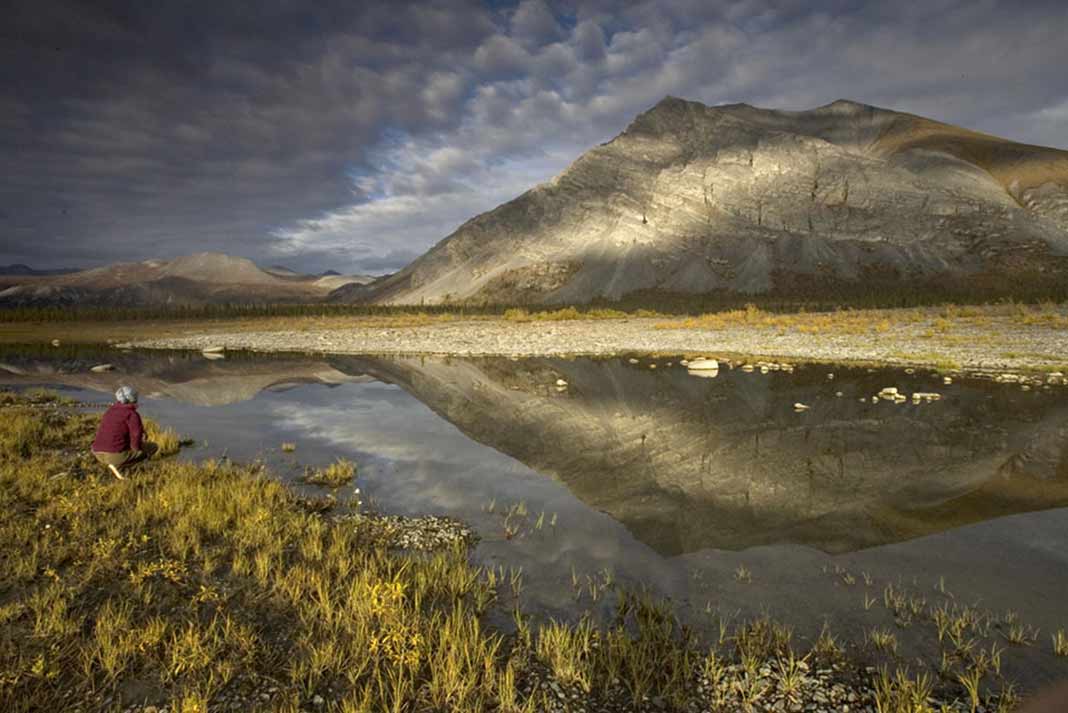
Dear EarthTalk: What’s the latest in the battle over whether or not to permanently protect the Arctic National Wildlife Refuge? The issue seems to come up every few years around election season, but I haven’t heard anything about it lately. — Gerald LaPlante, Boston, MA
The Arctic National Wildlife Refuge (ANWR), located on Alaska’s northeast coast, has been a conservation-versus-development battleground for decades. The 1.5 million acre coastal plain at the foot of the Brooks Range where the land meets the Arctic Ocean is the crown jewel of the 19 million acre refuge — and a magnet for iconic Alaskan wildlife like caribou, polar bears and wolverines. But oil interests say the coastal plain is covering huge oil and natural gas reserves and should be drilled for the sake of the U.S. and Alaskan economies.
Some 250 wildlife species consider ANWR home, while another 180 species of birds migrate through every year (from all 50 states and beyond). The coastal plain itself is a birthing ground for the region’s iconic caribou herd and also provides safe haven and sustenance for hundreds of other marine and terrestrial species. Environmental advocacy groups cite studies showing that industrial operations would deter animals from the area, robbing them of one of the last protected areas to raise their young.
Beyond biological pragmatism, conservationists argue that opening the refuge up to drilling operations would set a dangerous precedent, potentially opening the door for similar pressures on federal wilderness areas and even in national parks. Some of the key defenders of ANWR include the Alaska Wilderness League, Defenders of Wildlife, EarthJustice and others.
The other side champions the economic potential of the region. Alaska Governor Bill Walker has strongly supported drilling operations in ANWR, a stance shared by Alaska’s federal representatives. A 2007 Yale study showed the potential for $374 billion dollars of oil beneath ANWR. This would be vital income for the state government, which relies heavily on oil and gas tax streams for its budget.
Alaskan politicians say they need the extra revenue to pay to relocate climate refugees from villages inundated by rising seas. “We are in a significant fiscal challenge,” Alaska’s Republican governor Bill Walker told the BBC. “We have villages that are washing away because of changes in the climate.”
Nationally, supporters of drilling also cite economics: Every barrel of oil produced domestically puts tax money in the national coffers and creates local jobs. Shell has been the major commercial supporter of opening the refuge, though 78 percent of Alaskans share the sentiment. The state legislature has passed legislation opening ANWR to oil exploration — but it’s not theirs to decide since it’s on federal land.
But that doesn’t mean ANWR is safe from development. Inside the Washington, D.C. beltway, the Republican-dominated House passed a dozen resolutions in support of opening it up to oil exploration in the last session alone — although Democratic filibuster efforts were able to block any such legislation. Meanwhile, Senate Democrats Michael Bennet (CO), Ed Markey (MA) and 32 Democratic co-sponsors introduced legislation last December calling for permanently designating the most sensitive sections of ANWR as wilderness, off limits to development. With bigger fish to fry right now, lawmakers might not consider the legislation until a new president is in office, but backers of protecting ANWR can urge their senators to support the bill via an easy-to-send customizable online form letter courtesy of the non-profit EarthJustice.
CONTACTS: ANWR, www.fws.gov/refuge/arctic; Alaska Wilderness League, www.alaskawild.org; Defenders of Wildlife, www.defenders.org; EarthJustice, www.earthjustice.org. Photo above: Senate Democrats Michael Bennet and Ed Markey introduced legislation last December calling for permanently designating the most sensitive sections of ANWR as wilderness off limits to development. Credit: U.S. Fish & Wildlife Service.

Chances are your tap water is fine — a recent survey of public data by the non-profit Natural Resources Defense Council (NRDC) found that 95 percent of the U.S. population lives in areas without any past or present water contamination issues — but of course, it can’t hurt to check. According to the U.S. Environmental Protection Agency (EPA), most of us get our water from a community/public water system that provides its customers with an annual water quality report, also known as a Consumer Confidence Report. Typically this report comes out once a year — often with your July water bill. These reports contain information on contaminants in the system and in the water’s source — and what the potential health effects could be. Your water utility should be able to provide this report on request, as well.
If your water provider’s report doesn’t bring you solace, or if you are suspicious about the water pipes into your house, you can order a home water test kit and analyze for common contaminants yourself. National Testing Laboratories (NTL) is one of many companies that will mail you a complete test kit which you can use to test for various contaminants. NTL’s basic kit to evaluate water from your public water supply retails for under $150 and tests for the most common contaminants in public water supplies, including five metals and minerals such as copper and lead, seven inorganic chemicals including fluoride and nitrates, four physical characteristics including pH and hardness and 16 disinfectants and disinfection by-products including chlorine, trihalomethanes and haloacetic acids. Meanwhile, NTL’s deluxe option costs another $100, but includes tests for dozens of additional contaminants including arsenic, mercury, benzene, MTBE and even Glysophate (RoundUp).
If you are one of the 15 percent of the U.S. population deriving their water from a private supply, such as from a well on your property or a common source shared by a small neighborhood, it behooves you to test your supply on an annual basis (or more frequently if you have a new well or recently replaced or repaired pipes, pumps or well casings) to watch out for coliform bacteria, nitrates, total dissolved solids and unhealthy pH levels. Your local health agency can refer you to testing labs in your area that can provide sample containers or even come out to your property to take their own samples, or firms like National Testing Laboratories can mail well water test kits your way.
If your water supply is contaminated, contact your city, town or county health agency to find out what you can do to remedy the situation — and in the meantime, boil any water you intend to drink, or get bottled water. If you are on a public water supply, chances are your home isn’t the only one affected, so band together with neighbors and demand your water utility clean up its act. The silver lining to the Flint, Michigan water debacle is that Americans no longer take for granted that their water supplies are safe. Hopefully that will translate into more public vigilance regarding end-of-the-faucet monitoring of our precious water.
CONTACTS: NRDC’s What’s in Your Water,” www.nrdc.org/resources/whats-your-water-flint-and-beyond; National Testing Laboratories, www.watercheck.com; EPA Ground Water & Drinking Water, www.epa.gov/ground-water-and-drinking-water.

No doubt, solar power is surging. The trade group Solar Energy Industries Association (SEIA) reports that our domestic solar power capacity has seen a compound annual growth of nearly 60 percent over the last 10 years. Meanwhile, solar accounted for 28 percent of all new power added to the U.S. electric grid in 2015 and the prices of photovoltaic panels have fallen so steeply that solar is now cost-competitive with coal or natural gas in some parts of the country. And there’s no sign of solar slowing down anytime soon.
But just because Americans are warming up to solar doesn’t mean that every company looking to lead this power revolution has been able to manage the growth and navigate the tricky world of shifting subsidies and incentives. The most infamous case of a solar company flare-out is Solyndra, a California-based start-up that was pioneering the design and manufacture of thin film photovoltaic cylinders and secured $545 million in federal loan guarantees from the Obama administration’s economic stimulus package.
“But a solar manufacturing boom in China crushed the price of conventional crystalline photovoltaic (PV) solar panels,” reports David Ferris and Saqib Rahim in EENews’ EnergyWire. “The economic rationale for Solyndra’s pricey tubes was undermined, and the company declared bankruptcy in August 2011.”
Solyndra’s demise was certainly an embarrassment to the Obama administration, which had been touting the company as an example of the direction we should be heading in our energy sector, and argued poorly for the future of the still nascent green economy. But despite the setback, solar has grown at a record clip since 2011, surpassing wind as the largest renewable energy source in California.
This very maturation of the solar power industry in the U.S. made the April 2016 news of the bankruptcy of SunEdison, one of four remaining big players in the American solar industry, that much more surprising, given that the company was much larger in employees and revenues than Solyndra and had received more federal subsidies and loan guarantees overall.
“SunEdison’s bankruptcy, for creditors, customers, shareholders and partners, is a very big deal with all manner of negative repercussions,” comments Clint Wilder of the clean-tech advisory firm Clean Edge, “and it’s a cautionary tale like those we’ve seen across the energy landscape and in other industries, where over-leveraged, aggressive growth strategies can come crashing down.”
Meanwhile, America’s remaining solar powerhouses — SunPower, SolarCity and First Solar — continue to expand judiciously. And hundreds of smaller players are working to shake up the industry even further and keep the bigger players on their toes. While the growing pains for America’s solar industry are far from over, the future still looks bright for solar power, specifically, and renewables of all kinds.
CONTACTS: SEIA, www.seia.org; EnergyWire, www.eenews.net/ew; Clean Edge, www.cleanedge.com; SunPower, www.sunpower.com; SolarCity, www.solarcity.com; First Solar, www.firstsolar.com.

By now, we’ve all heard about bees dying across the U.S. and around the world. This isn’t just bad news for beekeepers: these amazing insects pollinate upwards of two-thirds of our food crops — all at no cost to farmers or consumers. All we need do is keep them around, which is proving to be more and more difficult.
A third of all beehives in the U.S. have disappeared in the last decade alone, a situation that has been dubbed Colony Collapse Disorder. Experts say several factors are at play. First, global warming has changed weather patterns so profoundly that bees have been unable to adapt fast enough. Flowers now bloom so early or late that they don’t coincide with the active season of pollinators, so when bees emerge from hibernation the flowers they need for food have already bloomed. Another threat is habitat loss: development, urbanization and monoculture farming are decimating natural areas bees need to thrive. And a new generation of parasites is infiltrating hives and impeding chemical communication between bees.
But perhaps the biggest threats to bees are some of the pesticides routinely used in agriculture, particularly neonicotinoids. Commonly referred to as neonics, this increasingly popular class of insecticides is meant to eliminate pests, but has been proven to have an equally devastating impact on bees. Today, seeds are engineered with neonics from the start, so this harmful chemical is present in the plant, pollen and nectar. This chemical, approximately 6,000 times more toxic to bees than DDT, devastates bee central nervous systems and makes it impossible for them to relocate their hives. Those bees that survive a first encounter aren’t off the hook. They remain dazed and inefficient. Neonics have an addictive quality similar to that of nicotine for humans, so surviving bees inevitably return to treated flowers until their death.
Policy changes must address this issue by rewarding farmers for sustainable practices and banning neonicotinoids for use as pesticides. Unfortunately, big agri-chemical companies like Dow Chemical and Syngenta make huge profits selling neonics and are reluctant to withdraw them. The European Union took steps to ban the use of neonics in member countries in 2013, although that ruling is currently under review. Meanwhile, in the U.S., a few cities and states have taken at least symbolic action to reduce neonics, but without a federal ban on the books such piecemeal efforts can’t do much to help.
In Spring 2016, Jeff Merkley (D-OR) introduced a bill in the U.S. Senate calling for new policy initiatives and interagency coordination to restore and enhance pollinator habitat across the U.S. Key provisions of Merkley’s Pollinator Recovery Act include setting aside three million acres of public land as expanded acreage for “forage and habitat” for pollinators, grant funding for R&D to develop crops to resist pests without neonics, financial incentives and technical assistance for farmers that adopt pollinator-friendly practices, and expanded health monitoring and population tracking for bees and other key pollinators.
Concerned Americans should urge their Senators to co-sponsor or support the Pollinator Recovery Act. After all, protecting bees isn’t just important to environmentalists but to anyone who enjoys avocados, almonds or any of the countless fruits, vegetables or nuts pollinated by our little black and yellow friends.
CONTACTS: Greenpeace “Save the Bees” Campaign, www.greenpeace.org/usa/sustainable-agriculture/save-the-bees; Merkley Unveils New Proposal to Help Restore Pollinator Populations Across the U.S., https://www.merkley.senate.gov/news/press-releases/during-national-pollinator-week-merkley-unveils-new-proposal-to-help-restore-pollinator-populations-across-the-us.












